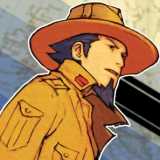Monthly Roundup, November 2013
By majormitch 6 Comments
The annual November deluge is now behind us: new consoles are out, and so are a ton of new games (on platforms both new and old). I’ve done my best to keep up with it all, but I can only do so much. I came out of the month with one of those consoles (a PlayStation 4) and a handful of new games, some of which I managed to play through. A chunk of The Wonderful 101 and the Dark Souls DLC (finally) compromised the first half of my month, and Resogun, Killzone: Shadow Fall and The Legend of Zelda: A Link Between Worlds the second half. I don’t feel a need to talk more about Dark Souls (though I liked the DLC), and don’t have much to say about Killzone (it’s a Killzone game), but here are my thoughts on the rest.
The Wonderful 101
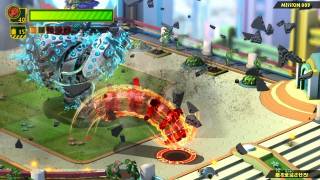
I played about a third of The Wonderful 101 in the first half of the month (I finished "Operation 003" out of 9 total), which took a surprisingly long time. I’ve spent at least six or seven hours with the game thus far, and if that pace holds firm for the rest of the game then that’s one lengthy action game. That could be a good or bad thing depending on your tastes and priorities, but for me in this particular case it’s become a downer. While I don’t think The Wonderful 101 is necessarily a bad game, I can’t say I’ve been having much fun with it, and I also find it to be a drag. The individual stages are very long and repetitive, and there’s precious little variety in both the enemies and your moveset. Even with all the different attacks you can “draw,” all the ones I’ve unlocked so far are functionally the same in a fight. In other words, they’re simply different tools for you to mash A with. The combat boils down to basic attack, dodge and block patterns, and while that standard template does its job competently, it also gets old fast against the same enemies ad nauseum. There’s a reason most action games are closer to 10 hours than 20, and that’s where The Wonderful 101 is losing me. It feels like it’s stretched way too thin for its own good, and I’ve already gotten bored only a third of the way through.
When The Wonderful 101 does manage to break out of the constant cycle of combat, I think it fares even worse. So far I’ve encountered a few terrible puzzles, some rote quick-time events, a bad platforming section or two, and one really awful on-rails chase sequence. The worst of these alternate scenarios are the indoor sections, which force you to play on the gamepad screen with gyroscope camera controls (gyroscope camera controls are quickly becoming one of my least favorite video game trends). Other than this glaring abomination, however, I haven’t had many issues with the game’s controls, despite all the brouhaha over them (I haven’t found the game too confusing or overwhelming either). I feel like I can attack, dodge and block as well as I need to, the only difference being that the game occasionally misinterprets the attack I’m trying to draw. It’s a slight encumbrance, but nothing game-breaking by any means, and these minor control issues pale in comparison to my larger issues with the game. Those issues are with its pacing and variety, those oft-overlooked critical ingredients that greatly influence how fun a game can be. Even The Wonderful 101’s vibrant look and energetic “Saturday morning cartoon” vibe hasn’t been able to liven it up for me, and I’m not sure exactly how much more of it I’ll play. I plan to give it at least one more solid shot before moving on for good, but I can’t promise how far I’ll get. I may write more if and when I play more, but that’s where things currently stand with The Wonderful 101.
Resogun
The first game I played on my PS4 was, naturally, Resogun. It’s an awesome little game that’s easily among the system’s best at launch (likely the best), and I’ve been surprised at how much I’ve enjoyed it. I don’t typically get into arcade shooters very much, as I’ve never been a “score chaser,” even if I often appreciate what those games do. Resogun makes a subtle but important change to that design: it offers a fun progression of levels across multiple difficulties. This allows me to focus on beating the levels and ramping up the difficulty for a stiffer challenge on successive playthroughs, rather than focusing purely on my score. That’s merely a personal preference of mine, but I do feel like it opens up the game to others like myself, and I would assume it still satisfies those who do like chasing top scores on leaderboards. Games like Geometry Wars or Pac-Man Championship Edition DX were arcade games that I really liked for their mechanics, but I didn’t play either one very long because I don’t care about high scores. Resogun fixes that issue for me.
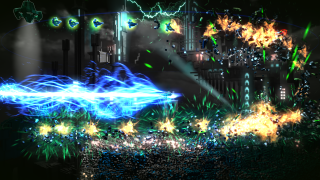
I also really like the mechanics of Resogun. The side-scrolling shooting that forms its core is simple and fun, with smooth movement and three distinct playable ships (with different speeds and weapon capabilities) forming solid groundwork. Even better is the enemy variety. Each of the five levels has a vastly different set of enemies that require different approaches, which makes each level feel pretty distinct. This all culminates in a boss for each level, which ended up being my least favorite moments of the game. Their set patterns are just not as exciting or interesting as the hordes of other dynamic enemies that can fill up the screen. Those encounters definitely get tough at times, and potentially overwhelming, yet I rarely felt like the game was too cluttered. It does a surprisingly good job at presenting things clearly amidst the chaos, and I rarely found myself frustrated as a result. The one occasion I did have visual issues pertains to the “keepers,” specific enemies that guard the humans you’re supposed to try and save in each level. They’re identified by a light green glow, which can be hard to spot when things get busy. This is especially problematic for the special keepers that need to be killed in a specific order, but the saving grace is that you don’t actually have to save the humans to progress. Saving them mostly gives you extra points, and occasionally extra bombs or lives. Nice things to have, but not necessary; human lives are only worth so much, after all. Anyway, Resogun is pretty great. I’ve had a lot of fun with it, and think it’s a great arcade style shooter that could appeal to a lot of different people. It’s also a great freebie to have on my PS4 on day one, and if you have access to it I think it’s totally worth checking out.
The Legend of Zelda: A Link Between Worlds
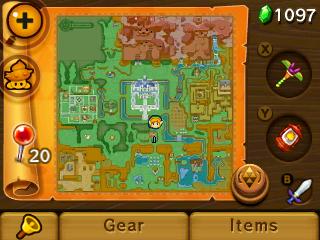
I managed to more or less blitz through The Legend of Zelda: A Link Between Worlds last week. Generally speaking, I consider The Legend of Zelda one of my favorite franchises, but the past few entries in the series haven’t really done much for me. Ever since Twilight Princess, each successive Zelda game has felt more restrictive and smaller in scope; the overworlds have gotten less ambitious, the side activities and secrets have gotten less exciting, and the amount of boring dialogue, fetch quests and other filler you have to put up with between dungeons have become a growing source of frustration. The dungeons themselves have remained excellent, and have kept the series at a certain level of quality regardless of whatever surrounds them. But as the years went on I found myself increasingly unimpressed with all of the shallow dressing around them. A Link Between Worlds, then, I can happily say is a return to form. Its overworld (pulled and “remixed” from A Link to the Past) is a joy to explore, full of exciting secrets and surprises that I had a blast discovering. Fetch quests are virtually non-existent, and the game spends hardly any time yapping at the player, instead content to let them go about their business with hardly any interruptions. A Link Between Worlds harkens back to the days where Zelda games simply dropped you into a world in peril, and let you set out on your quest. It doesn’t aim to guide you every step of the way, and the adventure is much richer for it.
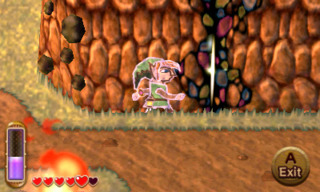
And yet, A Link Between Worlds doesn’t feel stuck in the past as much as you would think (and as much as I feared it might). First of all, this is a visually impressive game; easily the best looking top-down Zelda game to date, and I also think its controls are more responsive than they’ve ever been in the series (top-down or otherwise). Even more impressive is the soundtrack. Wind Waker has long held my favorite Zelda soundtrack, but A Link Between Worlds might give it a run for its money. Everything is beautifully orchestrated, and many of the rearranged pieces from A Link to the Past in particular are breathtaking (my heart skipped a beat the first time I heard the new Dark World theme). Furthermore, despite being “hands off,” the game is never as obtuse as, say, the original The Legend of Zelda. It does a smart job of communicating clearly through design and environmental cues in a way that’s simultaneously beneficial and unobtrusive. I felt that the past few Zelda games spent too much time spelling out every little detail to the player, almost as if they were afraid player wouldn’t “get it.” A Link Between Worlds more confidently and quietly guides the player, but guides them nonetheless. Finally, the game also experiments with the standard ways you acquire items and tackle dungeons. After only the first dungeon, most items become available to purchase, and the subsequent dungeons can be accessed in varying orders. This is most pronounced when you reach the Dark World, and all seven of its dungeons are immediately marked on your map. It’s a refreshing concession of agency to the player, and I loved being able to explore this world so freely.
All of this makes A Link Between Worlds the first Zelda game in a long time that I’ve found consistently fun to play. I don’t have to sit through awful reminder text or painful fetch quests just to get to the excellent dungeons. Those dungeons remains equally great (I haven’t talked about them much, but they are expertly designed as usual), and everything in between is just as good. The game looks to the series’ past, keeps a lot of the good while dropping most of the bad, and then updates and modernizes it in smart ways while managing to sprinkle in a few experimental twists of its own. A Link Between Worlds is not my favorite Zelda ever, but it’s easily my favorite in a long time, and has reinvigorated me on a beloved franchise I was starting to lose faith in.
Looking Ahead to December
I still have plenty of November games to catch up on, with Need for Speed Rivals, Super Mario 3D World and Tearaway topping my list. December (thankfully) rarely has big releases of its own, and generally ends up handling the excess from November’s annual gaming avalanche. This year is no different, and I haven’t given much thought to it past those November games. But if I have time I’d like to resume playing my backlog games, starting with Rogue Legacy, and also revisit the aforementioned The Wonderful 101. It’s anyone’s guess after that, but I plan to send off 2013 the way I know best: by playing lots of games.
